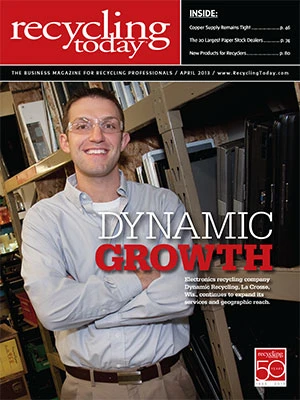
Making Headlines in 1973...
Jan. 27: Paris Peace Accords End U.S. Involvement in the Vietnam Conflict
April 30: White House Aides Resign Amidst the Watergate Investigation
June 9: Secretariat Wins the Belmont Stakes and, thus, the Triple Crown
Oct. 17: Arab Nation Oil Embargo against Countries that Support Israel Triggers Energy Crisis
Business Trends
New Players on the Scorecard
 A number of recycling companies that would grow in size and scope got their start in the 1970s, as the recycling of metals, paper and other materials grew by volume.
A number of recycling companies that would grow in size and scope got their start in the 1970s, as the recycling of metals, paper and other materials grew by volume.
In the Atlanta area, the company now known as Newell Recycling LLC got its start in 1976. Initially created as a heavy media plant, the company now offers complete scrap recycling services from more than 10 locations.
In 1977, the Galamba family started scrap metal recycling firm Galamet, which grew and served as a forerunner for David J. Joseph’s Co.’s Advantage Metals Recycling division in the Kansas City, Mo., area.
Industry Leaders
Cutler on the Cutting Edge
Throughout the 1970s, Herschel Cutler advanced several causes for the scrap recycling industry as a staff member of the Washington, D.C.-based Institute of Steel and Iron Scrap (ISIS). Cutler testified before government committees on issues such as price controls, railroad freight rates, recycling investment tax credits and liabilities emanating from the Superfund program.
Later, Cutler figured prominently in the merger of ISIS with NARI (the National Association of Recycling Industries) that formed the Institute of Scrap Recycling Industries Inc.
Consuming Markets
Front-Page News
The nonprofit group Conservatree, San Francisco, uses 1976 (the year of its founding) as a benchmark “before and after” year to mark the start of the race for the pulp and paper industry to use more recovered paper as feedstock.
“In 1976, almost all recycled content was preconsumer pulp substitutes, much of it mill scrap,” the organization writes in the history section of its website. “In 1976, there were few ‘recycled’ papers to choose from. In fact, most mills that used deinked pulp did not want anyone to know they were using recycled fiber. The few papers that were available were mostly book, text and cover grades,” adds Conservatree.
As well, though, by 1976 there were more than a dozen mills with deinking capabilities in North America, with many smaller mills up and running, even if they were absorbing just 250 to 300 tons per day as feedstock, according to the group.
Among those operations was a mill in Oregon City, Ore., then owned by The Los Angeles Times, which by 1975 was deinking and pulping about 25 tons per day. (That mill was eventually closed in 2011.)
Half a world away, in Australia, the Pratt family was adopting recycled-content technologies at its newsprint mills in that nation. “In the late ’70s and early ’80s, Visy opened its first paper recycling mills,” the company states on its website. “It was an investment that not only recognized the need to use our resources more sustainably, but also put Visy at the forefront of the recycling movement.”
Get curated news on YOUR industry.
Enter your email to receive our newsletters.

Explore the April 2013 Issue
Check out more from this issue and find your next story to read.
Latest from Recycling Today
- Fenix Parts acquires Assured Auto Parts
- PTR appoints new VP of independent hauler sales
- Updated: Grede to close Alabama foundry
- Leadpoint VP of recycling retires
- Study looks at potential impact of chemical recycling on global plastic pollution
- Foreign Pollution Fee Act addresses unfair trade practices of nonmarket economies
- GFL opens new MRF in Edmonton, Alberta
- MTM Critical Metals secures supply agreement with Dynamic Lifecycle Innovations





